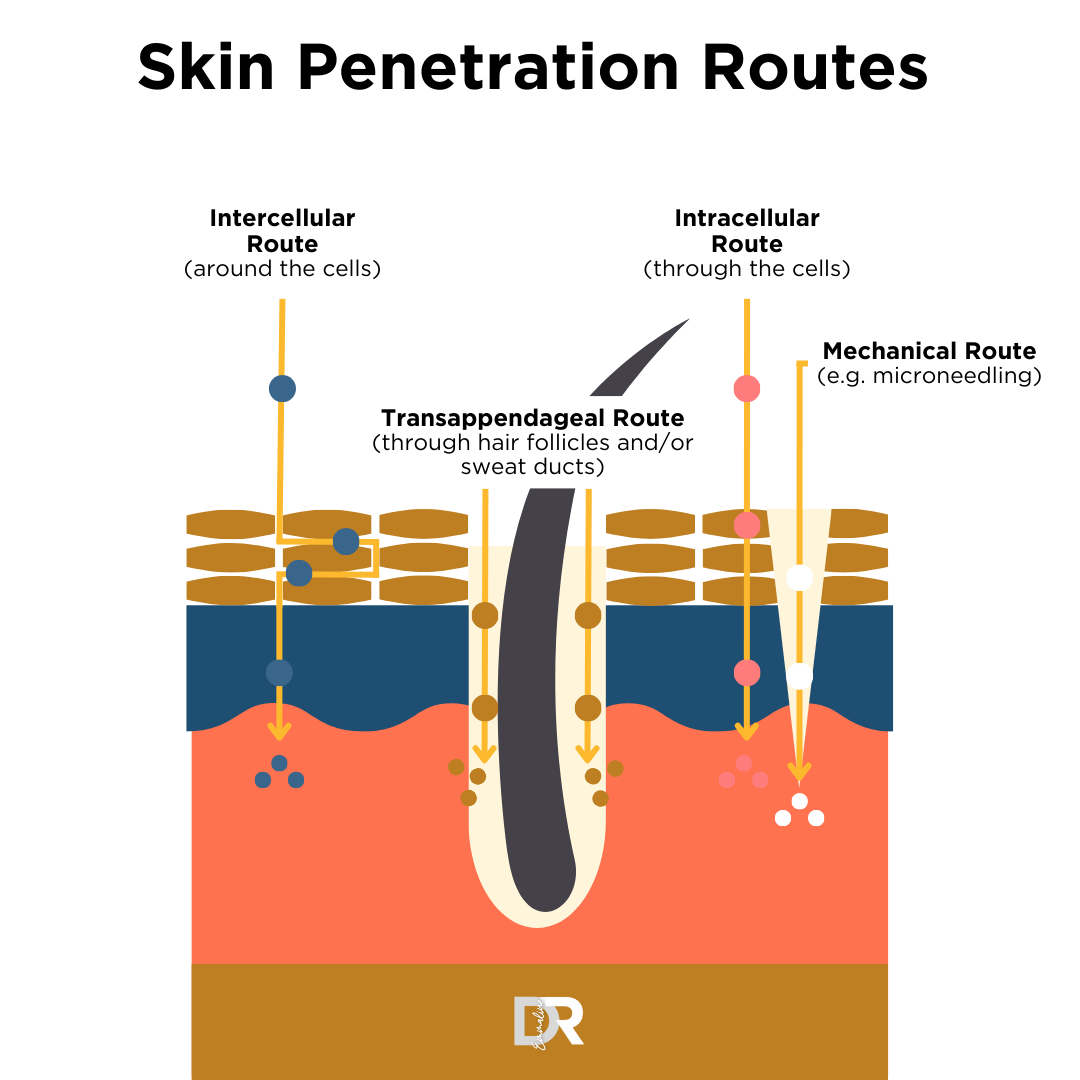How Do Skincare Ingredients Penetrate into Your Skin?
Attention all skincare enthusiasts! It's time to find out what really goes on with those creams, serums, and lotions that we slather onto our faces every day. Did you know that not all skincare ingredients can penetrate your skin? And that that you don’t always want them to?
Let’s do a little dive into the science behind your skincare.
The Structure of Your Skin
First, let’s remember the basic structure of the skin. And remember that your skin is a really, really effective barrier. It is designed to keep things out!
You have your top layer (the epidermis), your middle layer (the dermis), and the bottom layer (hypodermis). The epidermis consists of a watertight roof known as the stratum corneum, where cells are glued together with fatty acids. The primary function of this waterproof layer is to keep things out! The dermis contains blood vessels and vitally important structural proteins collagen and elastin. This is the layer that makes your skin appear plump and youthful.
It’s also useful to remember that the thinner the skin, the easier it is for skincare ingredients to penetrate. The skin of your face is thinner than the skin on your palms and the soles of your feet for example. The delicate skin around your eyes is the thinnest of all, so most vulnerable to sensitivities. Also, if you suffer from skin concerns that effect the integrity of your skin barrier like eczema or psoriasis, you might find that your ingredients penetrate much more fully than might be wanted.
So how does our skincare get into the deeper layers of our skin, and do we always want it to?
Absorption versus Penetration
Absorption refers to when an ingredient reaches the bloodstream. This is not what cosmetic skincare products do or what we want them to do. Penetration refers to when a chemical gets past the stratum corneum into the deeper layers of the epidermis. For most skincare ingredients, we are aiming for good penetration into the skin.
We don’t always want or even need skincare ingredients to penetrate further than this. In fact, most cosmetic skincare ingredients are designed to work on the epidermis. I’ll repeat this again, our skin is incredibly good at keeping things out!
Sometimes all we want is an extra, hydrating layer on top of the skin, nourishing the skin barrier and acting as an occlusive. For example, most hyaluronic acid in your skincare will sit on top of your skin, which is perfectly fine! Same with sunscreen. We want this sitting on top of your skin to protect it, not penetrating into the skin!
How do Chemicals Enter the Skin?
There are three main ways the chemicals can enter into the deeper layers of the skin.
Intercellular
Skincare ingredients can slip in between the cells of the stratum corneum. Remember, that the glue holding these cells together are fatty acids, so this meals that oils or lipids will have a better chance of getting into the skin this route. Water-based ingredients will not get into the skin via this method!
Intracecellular
This is when extremely tiny ingredients can actually slip into the cells of the skin and then through them.
Follicular
This is when ingredients can enter through openings that already exist in your skin - think of your pores and hair follicles. However, these tiny openings are few and far between, so very little skincare can enter into the skin this way.
What Factors Help a Chemical Get Into The Skin?
First and foremost, the size and weight of the molecule play a significant role in how well a skincare ingredient can penetrate the skin. Smaller molecules can penetrate better than larger molecules, such as collagen or elastin. The smaller size allows them to slip between the gaps in the skin cells and reach the deeper layers of the skin.
Another factor that affects penetration is the solubility of the ingredient. Oil-soluble or lipid-soluble ingredients, like essential fatty acids, can penetrate better than water-soluble ones because the skin is waterproof. Therefore, ingredients that can dissolve in oils can pass through the skin barrier more easily.
The polarity or charge of the molecule is also important. Non-polar or neutral molecules can penetrate better than polar or charged ones because the skin is negatively charged. This means that positively charged molecules, like some peptides, may have a harder time penetrating the skin barrier than neutral or negatively charged molecules.
The condition of the skin also plays a crucial role in the absorption of skincare ingredients. Hydrated, exfoliated, and treated skin can allow better penetration than dry, flaky skin. When skin is dry, it can form a barrier that prevents the ingredients from penetrating. This is why it's essential to keep your skin hydrated and well-moisturized to ensure that your skincare products can work their magic.
Finally, some skincare products also use special delivery systems, such as encapsulation or liposomes, to help the ingredients reach deeper layers in the skin. Encapsulation involves trapping the active ingredients inside tiny capsules that can penetrate the skin barrier more effectively. Liposomes, on the other hand, are tiny bubbles made of the same material as cell membranes that can transport the ingredients directly to the cells that need them. Skincare ingredients can penetrate the stratum corneum, the outermost layer of the skin, through a variety of mechanisms. One common method is through the use of penetration enhancers, which can help to increase the permeability of the skin. These enhancers can take on different forms, such as making the outer layer of the skin more permeable fluid, disrupting the proteins and oils on the skin, or hydrating the skin. Examples of penetration enhancers include fatty acids, alcohols, and surfactants. You can also use liposomes, which are small, spherical structures that can encapsulate and deliver active ingredients to the skin.
Various tools such as ultrasound, electroporation, iontophoresis, heating, and microneedles can also be used to increase penetration. These techniques drive the ingredients into the skin or disrupt the skin barrier.
Final Thoughts
The ability of a skincare ingredient to penetrate the skin depends on several factors, such as the molecular size, solubility, and the presence of other ingredients that can enhance or inhibit absorption. Once a skincare ingredient penetrates the skin, it can interact with various skin cells and structures to provide benefits such as hydration, exfoliation, or anti-aging effects.
Remember, we don’t always want to need skincare ingredients to penetrate into the skin. Protective and hydrating ingredients are designed to sit on the surface of the skin.






When it comes to skincare, acids have long been the stars of the show—think glycolic, salicylic, and hyaluronic acids. These tried-and-tested ingredients have earned their reputation for addressing common skin concerns such as acne, wrinkles, and dryness.
But did you know there are lesser-known acids that are starting to make their mark in the skincare world? While some have been used for centuries, others are still emerging in research. In this blog, we’ll introduce you to some skincare acids you may have never heard of, discuss their potential benefits, and help you decide whether they should make their way into your routine.